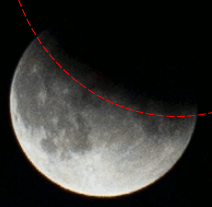Can you use mathematics to prove that the earth is round? That’s a question we get from time to time, sometimes from people who want to prove the earth is flat, sometimes from people who want to convince their friends otherwise, and sometimes just from students. Let’s think about it.
Can we prove it using math?
I’ll start with this direct question, from 1996:
Proof: Earth is Round I was wondering if you could settle a bet. My friend, who is a philosophy major, says the earth is flat. I say it's round. He's telling me the premises for determining that the earth is round are false. How can I explain, using math (he will agree with Pi = 3.14, simple trig and geometry, and standard definitions of distance) that: 1) The earth has a definite curvature 2) One can determine a general position on earth fixing with stellar points 3) The circumference of the earth (in km) 4) And prove that the earth is round I remember from high-school trig that it is possible (using a sextant) but if you could provide some general theories, I would appreciate it. Also within those parameters I can't use items like pictures because they can be forged. Yes, he is a candidate for the flat earth society.
Nathan recalls learning how to calculate the circumference of the earth (and also that you can find your location by angles to the stars, which implies roundness); he seems to be primarily looking for that, but the philosophical question is deeper. I wouldn’t be too surprised if the would-be philosopher was just engaging in some epistemological experimentation, and wasn’t quite serious, but you never know.
Doctor Ceeks didn’t exactly take the side of the philosophy major, but came close:
You cannot prove that the Earth is round or flat using mathematics. Mathematics does not answer questions about the way the world is. Your question is a physics question. While it is true that much physics uses mathematics, and it is quite wonderful that this is so, nevertheless, mathematics is not really concerned with the physical world. This has the happy corollary that mathematics is not bound by physical laws.
Mathematics studies abstract systems such as geometry, involving idealized points, lines, etc. (which have no width, are perfectly straight, and so on). It answers questions about the real world only after we model some aspect of the world in mathematical terms. We can, for instance, assume that the world is (approximately) a sphere, and do some calculations based on real-world data; but the calculations can’t prove the assumptions. (We’ll be seeing later how data can support the claim that the earth is round, and can contradict the claim that the earth is flat, but proof is a stronger claim than that, and mathematicians are concerned to preserve the proper meaning of “proof”!
In any case, to address your question, we can ask what is meant when one asserts that the "Earth is flat," or the "Earth is round." Both statements are a model of reality. Demanding to know which of the two is really true does begin to border on the philosophical, but in terms of practicality, one of the two models may serve to promote understanding of numerous facts... such as that Columbus never fell off an edge of the world.
So the round earth view is more useful, because it makes many predictions that fit our experience of the world (despite being contrary to our first impressions); but that is science, not mathematics.
If you can provide a simple principle which explains many things, you make it easier for people to do things. For example, no one will ever really know if there really is a gravitational inverse square law, but it has proven a wonderful model which enabled people to get Neil Armstrong to the moon.
This is one of the foundations of science: A model that explains more data is considered more valid, but any model may later be supplanted by one that explains even more. Science can’t prove anything absolutely (as mathematics can, because it only makes claims about abstract things within its own world), but it can provide support for hypotheses.
Besides, on closer inspection, both models of the Earth are likely false, as anyone who's tried to hike up a mountain can testify.
This punch line is more significant than you might initially think. What he is saying is that the earth is not exactly flat, nor exactly spherical, because neither model would have places where you can walk uphill. The flat earth and spherical earth hypotheses are not exact, mathematical claims, but general descriptions of the nature of the earth at a large scale. (Of course, “round” doesn’t actually mean spherical, just “not flat”, or at least “more or less spherical”.) To prove something true, you have to first define the claim clearly!
This answer was not fully satisfying, because there’s a lot more to be said.
Eratosthenes didn’t prove it!
We got a similar question, from the opposite direction, in 1999:
Measuring the Circumference of the Earth I have to prove the earth is round using a mathematical formula easy enough for any family member to use. My proof must contain a diagram, a mathematical formula, a solution to that formula, and the answer. I have done the other half of the research, which involved finding the first people to prove the earth was round (how they did so and when). I really need your help.
This detailed assignment assumes the roundness of the earth can be proved mathematically. Can it?
I answered, initially along the same lines as Doctor Ceeks:
Hi, Maria. Technically, you can't prove the earth is round using only math; you need some observations of the real world. I suspect that you are expected to report about how Eratosthenes determined the size of the earth in ancient Greek times. For that information, you could search either in Dr. Math or on the Web as a whole for "Eratosthenes" and "Earth." Basically, he knew the angle of the sun at the same time in two places a known distance apart, and from that determined the radius of the earth using a simple formula.
Maria didn’t say whether her answer to “the other half” (the history) dealt with Eratosthenes’ measurement of the earth, or someone else. We’ll be looking at that story in detail next time.
But does that calculation actually prove the earth is round? Not really!
But that really isn't an answer to the question as stated, and perhaps pointing this out might stir up some good discussions in your class. The fact is, Eratosthenes already KNEW that the earth was round; his calculations didn't prove it, and couldn't. Here's how you can show that this is true: find the data he used, then assume that the earth is flat and the sun is some distance above the surface at noon. See if you can calculate how high the sun is. You'll find that you can get an answer that works just as well as the answer he gave for the size of the earth. (There's an interesting relation between the two answers, too.) So if I believed that the earth was flat, I could give as good an explanation of his experiment as he could assuming that the earth is round. Nothing has been proved.
What I’m saying here is that the data he used can be applied just as well to find the height of the sun if you assume the earth is flat, as it is to find the radius of the earth if you assume the earth is spherical. Math is applied to a model, and different models lead to different conclusions!
I’ll be carrying out my suggestion at the end of this post.
In reality, the ancient Greeks and others knew the earth was round based on more general knowledge: that the earth's shadow on the moon during a lunar eclipse is round; that ships disappear over the horizon; and so on. But none of these involve a formula. Finding Eratosthenes' method is undoubtedly the intention of your assignment. You can find the details in our archives or elsewhere.
These are scientific observations that don’t really need math. For example, here is what you see in a lunar eclipse:


That “bite” is the shadow cast on the moon by a larger sphere, the earth. It is not what you see normally, just because the moon itself is round. In effect, what we see here is a selfie of the earth (in silhouette).
As for the ships … we’ll be looking at horizon calculations next week.
Maria would have to do what was expected, namely to explore the calculation of the size of the earth; but she might add the insights I’m suggesting for extra credit. We’ll see next time the explanations of Eratosthenes’ method that I referred her to; I added some helps she might need to understand the basic geometry:
Since the explanation in our archives doesn't give a picture or the formula, here's a drawing of his setup. The sun is directly overhead in one place and at an angle in another place:
|
| /
| /|
| /A|
no shadow | d / |
*********** / |
****** | ****** |shadow
*** | / ***
*** | / ***
* | / *
** | / **
* | / *
* | / *
* |A/ *
* |/ *
* * *
* *
* *
* *
* *
* *
* *
** **
* *
*** ***
*** ***
****** ******
***********
If you know the distance d to the place where the sun is directly overhead, and the angle A that the sun makes here, then we can say that
d A
--- = ---
C 360
where C is the circumference of the earth. Solve that for C and you're done.
Here’s the data Eratosthenes used, expressed in modern units: $$d = 500 \text{ miles}\\A = 7.2°$$ Therefore, $$C = \frac{360d}{A} = \frac{360\cdot 500}{7.2} = 25,000\text{ miles}$$ Since the circumference of the earth is about 24,901 miles, that isn’t at all bad. To find the radius, we can divide the circumference by \(2\pi = 6.283\), yielding $$R = \frac{C}{2\pi} = \frac{25,000}{6.283} = 3979\text{ miles}$$
What if Eratosthenes were a flat-earther?
Now here’s what I left her to try herself: Suppose we assume a flat earth. We’d draw this picture:
sun O
|\
|A\
| \
| \
H| \
| \
| |\
| |A\
no shadow| | \shadow
***********************************
<---d--->
Now we have $$\tan(A) = \frac{d}{H}$$ so that $$H = \frac{d}{\tan(A)} = \frac{500}{\tan(7.2°)} = 3958\text{ miles}$$
That’s essentially what we got for the radius of the earth! That’s the “interesting relation” I mentioned.
Now, if you gathered additional data from different locations, you’d start finding inconsistencies with this model; at the extreme, if you could go 6000 or so miles to the north (to the north pole), you’d find that on the same day, angle A is 90°, and H would become 0.
But the flat earth model was known to be wrong long before anyone traveled that far.
Next time we’ll look into the details of what Eratosthenes actually did.

Pingback: Eratosthenes Measures the Earth – The Math Doctors
Pingback: How Far Can I See? – The Math Doctors
Ok, sun rays… Shining through the clouds, just right, you can see a triangle formation almost (the ground being the bottom of the triangle). If the sun is actually 93 million miles away, wouldn’t those rays be more… parallel/straight instead of such definite angles? 2 angled lines will come to a meeting point, yes? Do you see what I’m saying?
And PS, the whole boat over the horizon thing has been debunked long ago. Wait for the boat to disappear, like normal, then pull out a camera with a good zoom, and boom, you can see the whole boat again.
Hi, Tiffany.
I think you’re talking about this sort of thing:

I got that picture from an article in Forbes (here) which answers your question, and a lot more. Here is a quotation from it:
So your question is essentially the same as if you asked, if these railroad tracks are really parallel, why do they form a triangle?

The difference is that it’s harder to see that the sunbeams are coming toward you, so you imagine them forming an actual triangle.
As for the boat thing … you need to be more careful whom you believe. Have you actually taken such a picture?
I tried to think of a simple mathematical proof.
I realised that the ratio of pole to equator distance and equator circumference would be different if the earth was flat.
Conveniently, pole to equator is 10,000 km, because this is where the unit is derived from.
If the Earth is flat, the equator, which is a circle around the pole, would be 62,832km, and if the Earth is a sphere, this distance is now a quarter of a circumference, so it would be 40,000km
(It measures 40,075km)
Here’s a diagram to better explain it: https://www.johnc.pro/sphere2.png
Also, here’s something I made in blender to better explain the crepuscular rays.
It’s two different views of the same object: https://www.johnc.pro/rays.png
If we define a set {a,b} where ‘a’ is the azimuth of Polaris and ‘b’ is the observer’s latitude, and the only solutions to the function f(a) = b are trigonometric, would that be considered “proof” that Earth is spherical?
Hi, Patrick.
The answer is no, for several reasons.
First, I suspect you meant altitude rather than azimuth. The latter is the direction relative to north, and would be essentially constant everywhere (namely, 0). The former is the angle above the horizon, and is essentially equal to the latitude, in the case of the North Star. (I say “essentially” because the star is not exactly in line with the axis of the earth.)
Second, “solutions to the function f(a) = b”, where a and b are the elements of a set, is meaningless. You probably were thinking of fitting a curve to a set of points (a, b) obtained by observation. But, as I just mentioned, this curve would be a line, not a trig function. And it would be only approximate, because of difficulties in measurement and the slight motion of the star. But that observed relationship would be strong evidence, that a spherical model is a good fit.
Third, I’m not sure what “latitude” would mean in a flat earth model, since its proper definition assumes the earth is (approximately) spherical. I assume they would define it as the altitude of Polaris! And they would have to come up with some explanation of how it varies from place to place, such that the angle changes in proportion to the distance traveled north. The issues that would arise are similar to applying the ideas in this post to Polaris rather than the sun, particularly my closing comments.